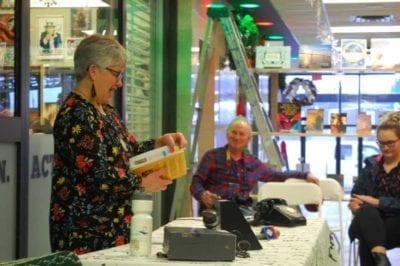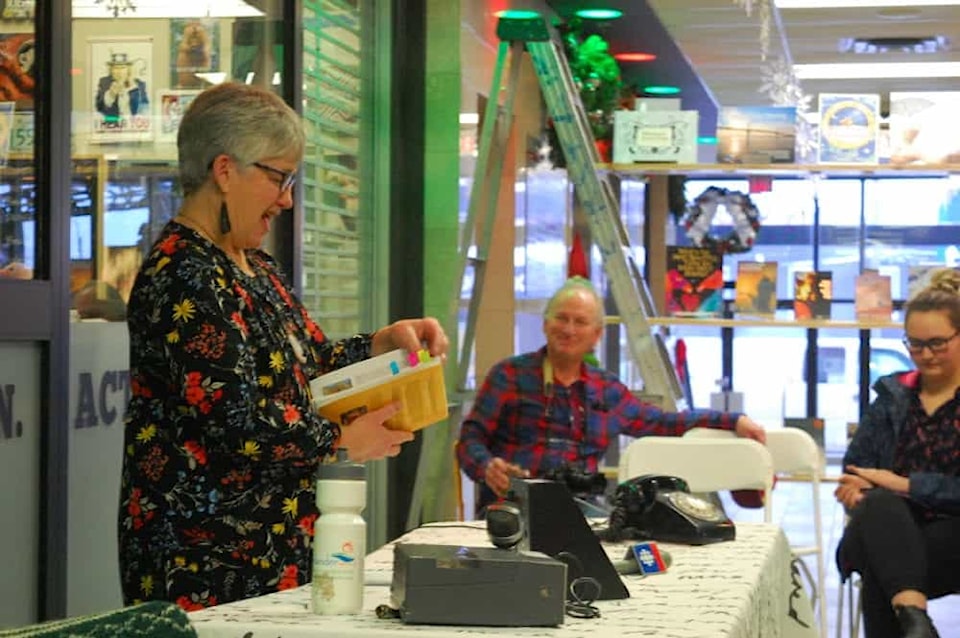Veteran journalist Patti-Kay Hamilton launched her new book in Yellowknife this past weekend.
Titled Trapline to Deadline: Trading a Skinning Knife for a CBC North Microphone, the book published by Cascade Publishing in Fort Smith follows Hamilton’s decades-long career as a Northern journalist.During the launch at the Book Cellar on Sunday, Hamilton shared passages with the audience.

December 2, 2018.
Patti-Kay Hamilton laughs as she shares stories from her new book Trapline to Deadline: Trading a Skinning Knife for a CBC North Microphone. The book is full of stories from Hamilton's 38-year career as a Northern journalist.
“When I started at CBC in ‘81, Louie interviewed me in his persona as the trapper and he said, ‘So miss, what’s it like to trade a skinning knife for a CBC microphone?’” Hamilton recalled.
Hamilton responded that they’re actually very similar. In 1987, she began having regular conversations on Morningside with host Peter Gzowski, who asked her a very similar question.
“In the first interview he said, ‘so what’s it like to go from the trapline to the world of deadlines?’”
Hamilton told him there are far more deadlines on a trapline than in a newsroom.
“I didn’t come to CBC the way most people did,” said Hamilton. When she was living on a trapline in the late seventies, CBC Radio wasn’t covering dog races the way she thought they should. So naturally, she and an old friend, Vi Beck, called up the boss at CBC.
“We called, his name was Graham Hall, British guy, very nice and polite to these screaming, ranting ladies,” said Hamilton.
Hall said he’d get back to them.
The next day, Hamilton was hanging laundry at her shack in Willow Flats, when Beck came peeling into the yard with the good news.
“They wanted us to be colour commentators at the race on the weekend,” said Hamilton.
But Beck had to handle dogs during the race, leaving Hamilton to broadcast alone.
“Vi cracked the whip. She made me go through with it. I did not want to do this, I’d never broadcast in my life,” said Hamilton.
During the live broadcast from a helicopter, the plan was that Hamilton would answer questions from a sports broadcaster. What was supposed to be a few minutes of chatting turned into a 17-minute breathless rant after Hamilton commandeered the microphone from the experienced broadcaster.
“I got a call at the floatplane base when the chopper landed. I figured that was it, my job was over,” said Hamilton.
But to her surprise, it was The Radio Show host Jack Farr asking her to do a live chat on the dog race the following day, opening the door to her career as a radio journalist.
Hamilton kept careful journals throughout that time, which this book encompasses.
But her 38-year career as a journalist was not without trials.
“I’ve been slapped, punched, dragged by my hair, had my ribs bruised. I live in Fort Smith, you understand,” said Hamilton.
But lately, with the rise of social media like Facebook, some of the comments directed towards reporters are just mean, she said. Media types are used to taking abuse from the public on the chin, but part of the reason she wrote this book is to show people the other side of the microphone.
“It’s tough. It’s really a hard job,” she said. “It’s mentally very tough. There’s tough things that reporters have to be neutral about and cover. And because you’re taking such careful notes, you don’t take care of yourself. There are stories I’ve covered that shredded me and I have nightmares about them still.
“I just wanted people to understand what it’s like,” said Hamilton.
